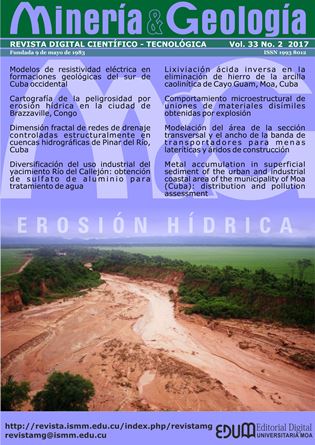Electrical Resistivity Models in Geological Formations in the Southern Area of the East of Cuba
Keywords:
geophysical modeling, electrical resistivity, vertical electrical survey, Los Palacios basin.Abstract
The purpose of this study is to develop electrical resistivity models in geological formations of greater interest for geological engineering in the southern area of the East of Cuba. A procedure for the generalization of the geo-electrical database was prepared to generate the referred geo-electrical models. A total of 38 works with 895 vertical electrical surveys, of which 317 (35.4%) located near (parametrical) drills. Three models for the Paso Real formation and one for the Capdevila, the most distributed in the region under investigation were defined. The surface quartz sands from the municipality of Sandino were identified to have higher electrical resistivity averages (1241 Ω•m), while they do not exceed 86 Ω•m in the lower horizons to resolve basic tasks of the geological engineering investigations. The assessment of the cover clayey sandy soils was satisfactory in both geological formations while the determination of the water table depth was unfavorable. The remaining tasks varied between relatively favorable to unfavorable according to the geological formations.Downloads
References
BARRIOS, E.; MARRERO, J.; PORTUONDO, A.; NUÑEZ, R. & PLACERES, R. 1988: Levantamiento geológico a escala 1:100 000 y búsqueda acompañante Pinar Sur. Informe ONRM, La Habana, Cuba, 297 p.
BASHKUEV, Y. B.; ADVOKATOV, V. R.; ANGARKHAEVA, L. K.; DORZHIEV, V. S. & HAYAKAWA, M. 2008: Maps of geoelectric sections of Turkey, Iran, Afghanistan, Pakistan, Korea and Japan. Natural Hazards and Earth System Sciences 8(4): 861-868.
FUNDORA, M. J.; CATANHA, M. & ALAMINOS, C. 2011: Plataforma SIG: Geoelectricidad en la prospección de aguas subterráneas. Caso de estudio: Luanda. En: VI Congreso Cubano de Geofísica. Memorias [CD-ROM], La Habana.
GARCÍA, J. A. 1996: Análisis de la efectividad del método de sondeo eléctrico vertical en investigaciones ingeniero-geológicas de obras hidráulicas en la zona premontañosa de la provincia de Pinar del Río. En: III Simposio Cubano de Geofísica. La Habana.
GARCÍA, J. A. 2011: Efectividad del método de sondeo eléctrico vertical en estudios ingeniero-geológicos en rocas serpentinizadas de la provincia de Pinar del Río, Cuba. En: VI Congreso Cubano de Geofísica. Memorias [CD-ROM], La Habana.
GARCÍA, J. A. & SACASAS, C. 2016: Mapas regionales de resistividad eléctrica en un sector al sur de Cuba occidental. Ciencias de la Tierra y el Espacio 17(1): 71-80.
IGP-SGN 2005: Mapa geológico de Cuba a escala 1:100 000 (versión digital). Instituto de Geología y Paleontología-Servicio Geológico Nacional, La Habana, Cuba.
KELLER, G. V. & FRISCHKNECHT, F. C. 1966: Electrical methods in geophysical prospecting. Pergamon Press, New York.
KUBA, A. 1973: Utilización de la exploración eléctrica para la búsqueda e investigación de las aguas subterráneas. Serie Geofísica No. 10. Academia de Ciencias de Cuba. 18 p.
MARTÍNEZ, D.; FERNÁNDEZ DE LARA, R. & PELÁEZ, R. 1988: Informe sobre los trabajos del levantamiento geológico y búsqueda a escala 1:50 000 en la parte central de la provincia de Pinar del Río. Emp. de Geología de Pinar del Río, Minbas, 959 p.
ORELLANA, E. 1982: Prospección geoeléctrica en corriente continua. Paraninfo, Madrid, 578 p.
PENG, F.; PENG, L.; ZHANG, J.; XUE, G.; MA, M. & ZHANG, Y. 2015: From Geophysical Data to Geophysical Informatics. Data Science Journal 14: 13. Consulta: 9 nov 2016. Disponible en: http://doi.org/10.5334/dsj-2015-013.
PEREIRA DE BARROS-DA SILVA, M. A.; FERNÁNDEZ-NÚÑEZ, H. M.; PEREIRA TEIXEIRA-PIRES & PÉREZ-LAZO, J. 2015: Obtención de parámetros geotécnicos de la ciudad de Luanda a partir de sondeos eléctricos verticales. Minería y Geología 31(2): 48-65.
TULSTRUP, J. 2004: Environmental data and the Internet: openness and digital data management. Geological Survey of Denmark and Greenland Bulletin 4: 45-48.
U.S.G.S. 2016: USGS Data management. Sitio web del Servicio Geológico de Estados Unidos de América. Consulta: 11 nov 2016. Disponible en: http://www2.usgs.gov/datamanagement/index.php.
VIDAL-MÉNDEZ, E. 2008: Cálculo de la conductividad hidráulica de los acuíferos a partir de la resistividad eléctrica. Minería y Geología 24(2).
Informes del archivo ENIA Pinar del Río utilizados (código y año): S-185 (1995); S-120 (1984); MT-56 (1988); S-156 (1988); S-146 (1987); S-102 (1981); S-103 (1981); S-146 (1987); S-143 (1987); G-73 (1989); SJ-26 (1983); SJ-50 (1988); PR-511 (1984); PR-843 (1990); SJ-13 (1978); PR-677 (1987); PR-464 (1982); PR-654 (1987); PR-732 (1988); PR-344 (1980); PR-587 (1985); PR-555 (1984); PR-786 (1989); PR-645 (1987); PR-711 (1988); PR-653 (1987); PR-419 (1981); PR-625 (1986); PR-684 (1987); PR-588 (1986); CS-196 (1988); CS-198 (1988); CS-162 (1986); CS-146 (1985); CS-186 (1988); CS-108 (1982); P-107 (1986); CS-109 (1982); P-88 (1982); P-114 (1987); P-103 (1986); SC-152 (1982); SC-278 (1993); SC-281 (1990); C-55 (1987); SC-167 (1983).
Published
How to Cite
Issue
Section
Copyright (c) 2017 José Antonio García-Gutiérrez, Carlos Sacasas-León

This work is licensed under a Creative Commons Attribution-NonCommercial 4.0 International License.
- Authors retain copyright and guaranteeing the right magazine to be the first publication of the work as licensed under a Creative Commons Attribution-NonCommercial that allows others to share the work with an acknowledgment of the work's authorship and initial publication in this journal.
- Authors may establish separate supplemental agreements for the exclusive distribution version of the work published in the journal (eg, place it in an institutional repository or publish it in a book), with an acknowledgment of its initial publication in this journal.
- Authors are allowed and recommended to disseminate their work through the Internet (e.g., in institutional telematic archives or on their websites) before and during the submission process, which can produce interesting exchanges and increase citations of the published work. (See The effect of open access)










